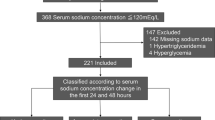Abstract
Introduction
Thiopental is a cornerstone in the treatment of refractory status epilepticus and intractable intracranial hypertension. In our center we observed that thiopental might cause falsely elevated serum sodium levels.
Methods
Triggered by a recent case experience of extremely elevated serum sodium levels during thiopental treatment, we retrospectively identified 53 patients treated with thiopental in our intensive care unit between 2007 and 2011 and evaluated electrolyte changes. We differentiated the analysis before and after introduction of a new device for sodium assays (Dimension Vista, Siemens) in the central laboratory in April 2010. Standardized in vitro laboratory tests were performed to study the effect of thiopental on sodium analysis.
Results
Before April 2010, serum sodium levels determined in the central laboratory showed a good agreement with the bedside point-of-care (POC) device during thiopental therapy with [sodium]laboratory − [sodium]POC of only 1.08 mmol/L (P = .0517). After April 2010, a strong discrepancy between laboratory values and POC values was observed with [sodium]laboratory − [sodium]POC = 11.57 mmol/L (P < .0001). Standardized in vitro testing confirmed that thiopental induced a dose-dependent false hypernatremia (P = .002).
Conclusions
Thiopental treatment can result in falsely elevated serum sodium. This is a critical finding since high sodium levels preclude administrating mannitol or hypertonic saline for the treatment of elevated intracranial pressure. Moreover, a false high sodium level might lead to the inappropriate administration of hypotonic fluids potentially resulting in increased brain edema and even higher intracranial pressure. To our knowledge, this is the first paper describing this clinically relevant phenomenon.



Similar content being viewed by others
Abbreviations
- Na:
-
Sodium
- POC:
-
Bedside point-of-care laboratory device
- Rapidlab:
-
POC device
- Dimension Vista:
-
Central laboratory auto analyzer
- Vitros:
-
Central laboratory auto analyzer
- ICP:
-
Intracranial pressure
References
Brain Trauma Foundation, American Association of Neurological Surgeons, Congress of Neurological Surgeons, et al. Guidelines for the management of severe traumatic brain injury. XI. Anesthetics, analgesics, and sedatives. J neurotrauma. 2007;24(Suppl 1):S71–6.
Cordato DJ, Herkes GK, Mather LE, Morgan MK. Barbiturates for acute neurological and neurosurgical emergencies—do they still have a role? J Clin Neurosc. 2003;10:283–8.
Huynh F, Mabasa VH, Ensom MH. A critical review: does thiopental continuous infusion warrant therapeutic drug monitoring in the critical care population? Ther Drug Monit. 2009;31:153–69.
Bledsoe KA, Kramer AH. Propylene glycol toxicity complicating use of barbiturate coma. Neurocrit Care. 2008;9:122–4.
Ng SY, Chin KJ, Kwek TK. Dyskalaemia associated with thiopentone barbiturate coma for refractory intracranial hypertension: a case series. Intensive Care Med. 2011;37:1285–9.
Neil MJ, Dale MC. Hypokalaemia with severe rebound hyperkalaemia after therapeutic barbiturate coma. Anesth Analg. 2009;108:1867–8.
Cairns CJ, Thomas B, Fletcher S, Parr MJ, Finfer SR. Life-threatening hyperkalaemia following therapeutic barbiturate coma. Intensive Care Med. 2002;28:1357–60.
Tisdall M, Crocker M, Watkiss J, Smith M. Disturbances of sodium in critically ill adult neurologic patients: a clinical review. J Neurosurg Anesthesiol. 2006;18:57–63.
White H, Cook D, Venkatesh B. The use of hypertonic saline for treating intracranial hypertension after traumatic brain injury. Anesth Analg. 2006;102:1836–46.
Koch TR, Cook JD. Benzalkonium interference with test methods for potassium and sodium. Clin Chem. 1990;36:807–8.
Burtis CA, Ashwood ER, editors. Tietz fundamentals of clinical chemistry. 5th ed. Philadelphia: WB Saunders; 2001.
MAUDE Adverse Event Report: Siemens Healthcare Diagnostics INC—Glasgow Dimension Vista® Intelligent Lab System V-LYTE® Integrated Multisensor. 2010. http://www.accessdata.fda.gov/scripts/cdrh/cfdocs/cfmaude/detail.cfm?mdrfoi__id=1930779). Accessed 22 Oct 2012.
Conflict of interest
The authors declare that they have no competing interests. Neither the study nor the authors were funded.
Author information
Authors and Affiliations
Corresponding author
Rights and permissions
About this article
Cite this article
Feyen, B.F.E., Coenen, D., Jorens, P.G. et al. Falsely Elevated Sodium Levels During Thiopental Treatment in the ICU: Technical Interference on a Laboratory Device with Important Clinical Relevance. Neurocrit Care 18, 64–69 (2013). https://doi.org/10.1007/s12028-012-9794-x
Published:
Issue Date:
DOI: https://doi.org/10.1007/s12028-012-9794-x




